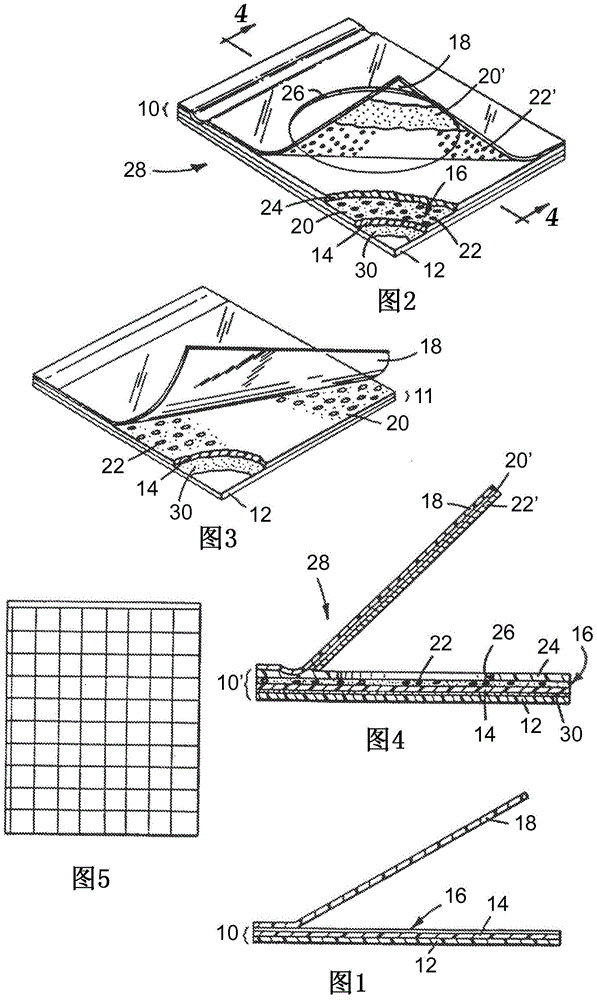Method and culture device for detecting yeasts and molds
A culturing device, yeast technology, applied to the culturing device of yeast or mold microorganisms, the field of detecting yeast and mold in samples, can solve the problem of low reproducibility, labor-intensive, extended type of mycelial growth hindering accurate counting of living cells, etc. question
- Summary
- Abstract
- Description
- Claims
- Application Information
AI Technical Summary
Problems solved by technology
Method used
Image
Examples
Embodiment A
[0102] Embodiment A is a kind of cultivating device, and this cultivating device comprises:
[0103] a body comprising a self-supporting substrate having a first major surface and a second major surface;
[0104] a first adhesive composition disposed on a portion of the first major surface of the substrate;
[0105] a substantially dry, cold water soluble first hydrogel-forming composition attached to the first adhesive composition; and
[0106] Multiple indicators, said multiple indicators include:
[0107] Three indicators for detecting different glycosidase activities;
[0108] An indicator for detecting the enzyme activity of alkyl esterase;
[0109] Indicator for detecting phosphatase activity;
[0110] wherein each of said plurality of indicators comprises a detectable reporter group.
[0111] Embodiment B is the culture device of embodiment A, further comprising a cover sheet attached to the body member.
[0112] Embodiment C is the culture device of embodiment B,...
Embodiment W
[0132] Embodiment W is a method for detecting yeast and mold in a sample, the method comprising:
[0133] contacting the sample and the aqueous liquid with a gelling agent disposed on the first adhesive composition or the second adhesive composition of the culture device according to any one of embodiments A to V, to form an inoculated culture device;
[0134] incubating the inoculated culture device for a period of time; and
[0135] Detection of yeast or mold colonies in the culture device.
[0136] Embodiment X is the method of embodiment W, wherein detecting yeast or mold colonies in the culture device comprises detecting the presence of a detectable reporter group of at least one of a plurality of indicators in the culture device, wherein Detection of the presence of a detectable reporter group indicates the presence of colonies of yeast or mold microorganisms.
[0137] Embodiment Y is the method of embodiment W or embodiment X, wherein the sample is contacted with the...
example
[0145] indicator
[0146] Chromogenic substrate indicators used in the Examples are listed in Table 4 and were purchased from Biosynth International, Inc., Itasca, IL.
[0147] Table 4.
[0148] Indicator name
CAS number
5-Bromo-4-chloro-3-indole acetate (X-3-acetate)
3252-36-6
5-Bromo-4-chloro-3-indole-β-D-galactopyranoside (X-Gal)
7240-90-6
5-Bromo-4-chloro-3-indole-β-D-glucopyranoside (X-b-Glu)
15548-60-4
5-Bromo-4-chloro-3-indole-α-D-glucopyranoside (X-a-Glu)
108789-36-2
5-Bromo-4-chloro-3-indole phosphate p-toluidine salt (BCIP p-toluidine)
6578-06-9
[0149] Each of the indicator coating formulations A-D (Table 5) was composed of five chromogenic substrate indicators in the amounts specified in Table 5 with 100 g of a non-inhibiting binder of isooctyl acrylate and acrylamide Copolymers (described below) were prepared.
[0150] table 5.
[0151]
[0152] Medium formula
[0153] Six s...
PUM
 Login to View More
Login to View More Abstract
Description
Claims
Application Information
 Login to View More
Login to View More - R&D
- Intellectual Property
- Life Sciences
- Materials
- Tech Scout
- Unparalleled Data Quality
- Higher Quality Content
- 60% Fewer Hallucinations
Browse by: Latest US Patents, China's latest patents, Technical Efficacy Thesaurus, Application Domain, Technology Topic, Popular Technical Reports.
© 2025 PatSnap. All rights reserved.Legal|Privacy policy|Modern Slavery Act Transparency Statement|Sitemap|About US| Contact US: help@patsnap.com



